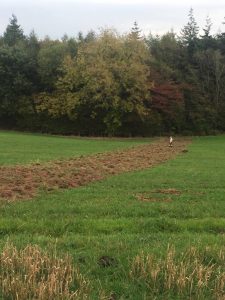Before becoming a mum spending time walking in mud and splashing in muddy puddles was not on my list of ways to have a good time. Things have certainly changed! We spend so much time outside and living in the country we are lucky to have so much nature on the doorstep. As part of the Autumnal RSPB challenge we have been out and about looking for animals and animal tracks.
The RSPB also have a downloadable sheet to try and help with all of the tracks you may see, my two loved using this :http://www.rspb.org.uk/Images/animaltracks_tcm9-133380.pdf
Why track animals with children?
- It connects them to nature in a very direct and hands-on way.
- It teaches them to be aware of their surroundings and the creatures that live there.
- It gives them a chance to use critical thinking skills and scientific inquiry methods.
- It gives them a chance to experience nature with both body and mind.
- It’s an incentive for both you and them to learn about different animal species in your area.
- It gives kids a chance to lead and problem solve in nature.
- It’s an incentive to go outside.
- It’s fun! (Honest)
 How to track animals with children
How to track animals with children
I am no expert but we decided the best thing to do was to start with looking for footprints. Whilst looking we talked about looking closely for fur, feathers, nests and bones. We spent time looking in trees and hedges not just the ground. We discussed using all our senses to help us find tracks and signs.
A good place to start looking for tracks and other signs of animal life is where animals feed, drink, bathe or gather. You also need good ground for the tracks to show. Mud, damp soil and sand are excellent surfaces. Damp woods, shady trails, seashores, and river banks are places where animals are both likely to be and leave tracks.
Animal tracking can be done with no equipment at all. But if you want to step it up a notch, or if you’re not sure how to identify different tracks these helpful tools are fun to include:
- Smartphone to document the tracks and/or to search for information online
- Field guide (in case you don’t have a smart phone or just prefer to look things up in a book)
- Nature journal for taking notes and making drawings of the tracks. (Works better when it’s not too cold outside.)
- Magnifying glass
- Binoculars
- Flashlight for after-dark explorations
- A check list for the animals whose tracks you may encounter. Make sure to include some that you’re likely to see, as well as some more unusual ones.
Obviously take into account what the weather is doing, wear appropriate clothing and footwear and never put yourself or the children in a dangerous situation. Depending on the walk and outing we sometimes make it into a day event and take lunch and snacks. Just always remember to pick up and take any left over snacks and rubbish with you. Also remember to ask permission to go on any private land and to keep to the contry code.
We got lucky and found plenty of tracks and even the animals that made the tracks. Let us know how you get on tracking and what you find.



Brilliant. I wish my parents would have done this sort of stuff with me when I was little.
We have lots of small field type reference books – seaside, fungi, trees, fossils and tracks. I love it.
I look forward to seeing what else you guys find.
Ooh how lovely to see deer up so close. It’s a great activity, I’ve never done it with my two but it’s on the list! My dad came face to face with a deer on his drive the other night. I’m not sure which of them was more surprised!
Nat.x